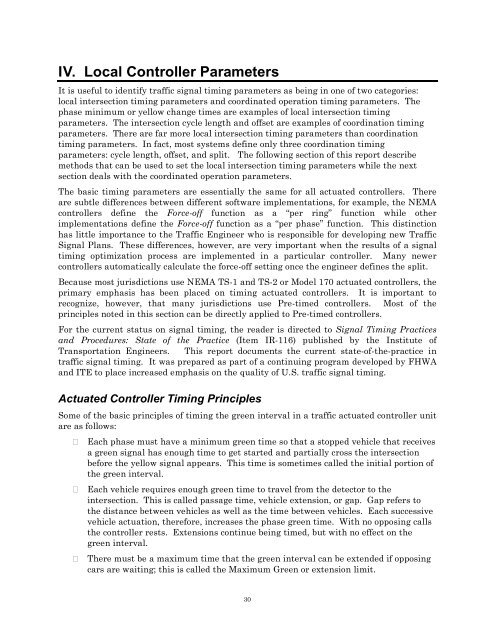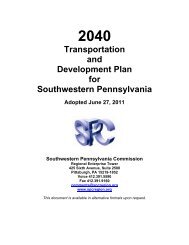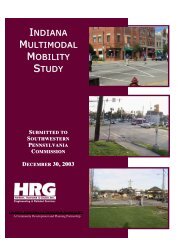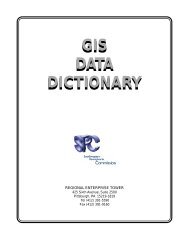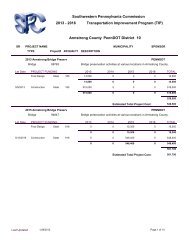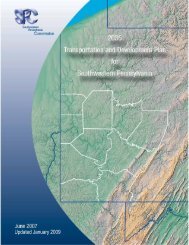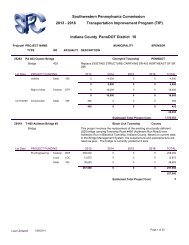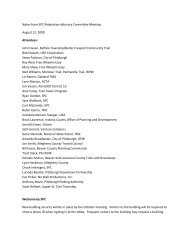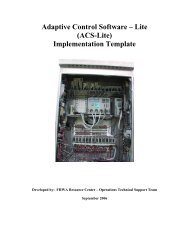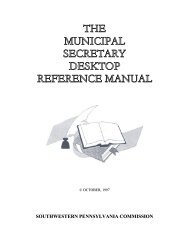FHA Signal Timing On A Shoestring
FHA Signal Timing On A Shoestring
FHA Signal Timing On A Shoestring
Create successful ePaper yourself
Turn your PDF publications into a flip-book with our unique Google optimized e-Paper software.
IV. Local Controller Parameters<br />
It is useful to identify traffic signal timing parameters as being in one of two categories:<br />
local intersection timing parameters and coordinated operation timing parameters. The<br />
phase minimum or yellow change times are examples of local intersection timing<br />
parameters. The intersection cycle length and offset are examples of coordination timing<br />
parameters. There are far more local intersection timing parameters than coordination<br />
timing parameters. In fact, most systems define only three coordination timing<br />
parameters: cycle length, offset, and split. The following section of this report describe<br />
methods that can be used to set the local intersection timing parameters while the next<br />
section deals with the coordinated operation parameters.<br />
The basic timing parameters are essentially the same for all actuated controllers. There<br />
are subtle differences between different software implementations, for example, the NEMA<br />
controllers define the Force-off function as a “per ring” function while other<br />
implementations define the Force-off function as a “per phase” function. This distinction<br />
has little importance to the Traffic Engineer who is responsible for developing new Traffic<br />
<strong>Signal</strong> Plans. These differences, however, are very important when the results of a signal<br />
timing optimization process are implemented in a particular controller. Many newer<br />
controllers automatically calculate the force-off setting once the engineer defines the split.<br />
Because most jurisdictions use NEMA TS-1 and TS-2 or Model 170 actuated controllers, the<br />
primary emphasis has been placed on timing actuated controllers. It is important to<br />
recognize, however, that many jurisdictions use Pre-timed controllers. Most of the<br />
principles noted in this section can be directly applied to Pre-timed controllers.<br />
For the current status on signal timing, the reader is directed to <strong>Signal</strong> <strong>Timing</strong> Practices<br />
and Procedures: State of the Practice (Item IR-116) published by the Institute of<br />
Transportation Engineers. This report documents the current state-of-the-practice in<br />
traffic signal timing. It was prepared as part of a continuing program developed by FHWA<br />
and ITE to place increased emphasis on the quality of U.S. traffic signal timing.<br />
Actuated Controller <strong>Timing</strong> Principles<br />
Some of the basic principles of timing the green interval in a traffic actuated controller unit<br />
are as follows:<br />
<br />
<br />
<br />
Each phase must have a minimum green time so that a stopped vehicle that receives<br />
a green signal has enough time to get started and partially cross the intersection<br />
before the yellow signal appears. This time is sometimes called the initial portion of<br />
the green interval.<br />
Each vehicle requires enough green time to travel from the detector to the<br />
intersection. This is called passage time, vehicle extension, or gap. Gap refers to<br />
the distance between vehicles as well as the time between vehicles. Each successive<br />
vehicle actuation, therefore, increases the phase green time. With no opposing calls<br />
the controller rests. Extensions continue being timed, but with no effect on the<br />
green interval.<br />
There must be a maximum time that the green interval can be extended if opposing<br />
cars are waiting; this is called the Maximum Green or extension limit.<br />
30


